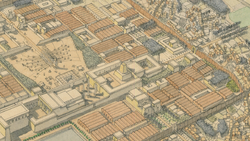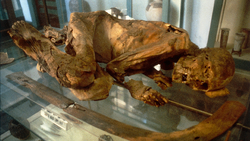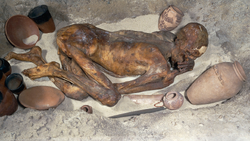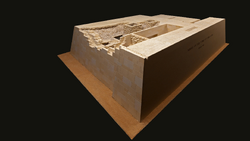Learn about early funerary monuments of ancient Egypt, and their evolution into the pyramidal structure we know so well today.

Heliopolis [Detail on Benben] / 2016 / Jean-Claude Golvin
The origin of the word “pyramid” is controversial. Most believe that it originates with the Greek word puramis, which referred to a bread of conical shape.
Life and death in ancient Egypt were modeled on the cycle of the sun. The perfect shape of the smooth-faced pyramid became associated with the metaphor of the pharaoh transformed into one of the sun's rays in death.
Pyramids represented the benben, the primordial mound of the Heliopolitan creation myth. These stories permeated every aspect of Egyptian life to a greater or lesser extent.

Mummified body / 3rd Millenium BCE / Museo Egizio, Turin, Italy
During the Predynastic period, the development of funerary practices was different depending on whether one was located in Lower Egypt or Upper Egypt.
Well before the pyramid, there was the burial pits.
It is on the site of Merimde Beni-Salame in Lower Egypt that we find the oldest funerary site, dating back to 5000 BCE.
Study of the tombs revealed that the bodies of the deceased were deposited in a shallow grave, in a fetal position. Though a few objects were recovered from these graves, they offered no insight as to the social class of those interred within.

Reconstruction of a man's tomb / Prehistory
In Upper Egypt, Predynastic practices are easier to study but reveal more complex funerary rites. They are divided into two cultural phases: Badarian and Nagada.
The Badarian phase ranged from 4400 BCE to 3800 BCE. Small necropolises were discovered on the outskirts of villages, revealing the emergence of a funerary cult.
The bodies of the deceased were lowered into an oval grave and covered with goat or gazelle skins. Items needed in everyday life were added atongside the body.
During the three Nagada periods, ranging from 4000 BCE to 3510 BCE, funerary practices evolved in complexity.
The shape of tombs changed from oval to rectangular, mimicking the homes of the living. The size of the burials increased and funerary items became more stylized and numerous.
Tombs gained complexity, with masonry, wooden veneers or raw bricks added to strengthen the structures.
In time, socially stratified necropolises emerged. For example, in Hierakonpolis, the elite and commoners had separate necropolises.

A mastaba in Gizeh / 1997 / Jean-Claude Golvin
The term mastaba, meaning “massive bench” in dialectal Arabic, refers to a form of funerary architecture that was present in Egypt from the archaic period to the Middle Kingdom.
An evolution of the burial pit, mastabas were generally composed of two parts. À structure was built above the ground in the form of a massive rectangle with stepped walls, and a subterranean burial chamber was located underneath.
Smaller mastabas often surrounded the much larger tomb of the king. These generally held the remains of the king's relatives, and courtiers.

Model of the Tomb of Perneb / 5th Dynasty
The arrangement of the substructure of the mastaba evolved during the course of the Old Kingdom.
From the 5th dynasty onwards, mastabas often featured multi-roomed substructures, with sometimes up to 30 rooms. Also, the quantity and quality of decorated surfaces increased noticeably, as well as the number of statues found within.

West6 wall of the chapel of Kaemsenu with niches for Iretnub, Kaemsenu and Werdjedptah / 5th Dynasty
The 6th Dynasty would see art used to its utmost. The entire surface of a mastaba would be covered in scenes of daily life, illustrating the prosperity of those lucky enough to comfortably spend eternity near the pyramid of a pharaoh.
The best example of this type of mastaba is the tomb of Mereruka, in Saggara.
